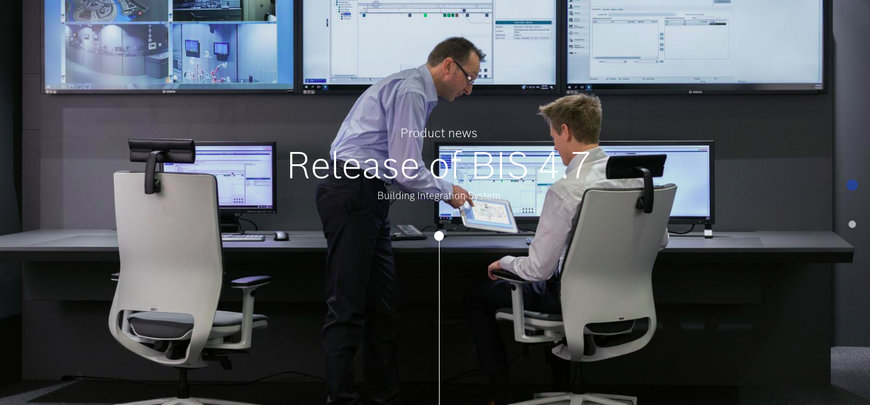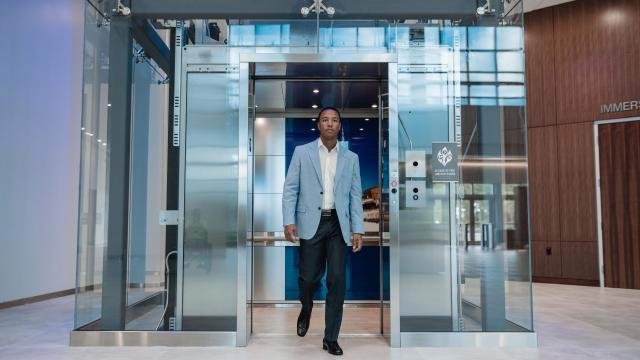smartbuildingmag.com
09
'20
Written on Modified on
BOSCH News
RELEASE OF BIS 4.7
Large installations, critical infrastructures and a wide range of commercial and public buildings face a real challenge when it comes to investing in an effective alarm management system. Not only must building owners be sure of an adequate alarm response to events or security breaches, any solution must also integrate with a diverse range of other systems to make it easy to control everything from security and safety to building automation.

The Bosch Building Integration System (BIS) had been proven to be the definite answer to all these challenges. It’s an efficient, reliable and cost-effective way to integrate the management of security, safety and building automation systems such as access control, video security, fire alarm, public address (PA/VA) and intrusion systems. But the real beauty of BIS is that it does it all on a single platform with one graphical user interface. It offers the flexibility to build a modular solution that you can tailor to connect and manage only the subsystems that you need. So you have maximum flexibility to evolve the system to meet the changing needs of your building – now and in the future.
BIS has already proven to be reliable in thousands of installations worldwide. Now, with the release of the latest version, 4.7, Bosch has added new functions that extend the system’s capabilities even further. These include the introduction of a mobile client app, threat level management for access control, and even more integration possibilities with trusted third-party subsystems.
Three modules, one solution

BIS 4.7 is a modular solution that uses three different modules – so-called engines - as building blocks, making it possible to add or remove elements, or create new combinations at any time. So you can grow, evolve and enhance your system to suit changing security, safety and building automation requirements.
The Security, Safety and Building Automation module (Automation Engine) enables the unified management of:
The Security, Safety and Building Automation module (Automation Engine) enables the unified management of:
- Fire systems: e.g. FPA-5000/1200
- Intrusion systems: e.g. B Series, G Series and MAP 5000
- Voice alarm / evacuation systems: e.g. PRAESIDEO and PAVIRO
- 3rd party building automation solutions: e.g. elevator management from Otis
The Access control module (Access Engine) provides a reliable way to fully-integrate access control management into a building:
- Works with the Bosch Access Modular Controller (AMC) to manage a wide range of readers and credentials from Bosch or third parties.
- Ideal for standard applications or the most demanding, personalized security solutions
The Video Security module enables users to manage their entire video security system centrally. Based on basic or advanced video management requirements, customers can choose between:
- Video Engine: delivering visual alarm verification that will significantly increase situational awareness. It covers analog devices, IP video devices, and recording devices from Bosch, as well as ONVIF-compliant third-party devices.
- BVMS: a highly-scalable video management solution with extensive alarm management possibilities and highest resilience for even the most demanding video security requirements. BVMS fully supports the complete video systems portfolio from Bosch including our unique forensic search and camera built-in Video Analytics, and recording devices. For even greater flexibility BVMS works seamlessly with ONVIF-compliant third-party devices.
Never miss an alarm with a new mobile client

Responding to the demand for greater flexibility and a faster reaction to security events, BIS 4.7 features a new web app for Android and iOS devices. It displays live updates of events and alarms for all security, safety and building automation domains that are connected to BIS, as well as their current status (new, accepted, or deleted). These can be configured according to specific needs, and are synchronized between users in case of multiple mobile client users. Once an alarm has been accepted by one user, it will no longer be visible to others, eliminating the doubling up of manpower to deal with an event.
When connected to the company network, the app sends push notifications to mobile devices*, even if the phone is in idle mode. This means that should operators be away from their workstations, for example on guard tour duties, they will never miss an alarm. By checking alerts on their mobile device, they can react quickly by going directly to the location of the event, or returning to their desk to escalate a response.
Increase safety with threat level management

In critical situations like fire, terrorist attacks, robberies or shootings, you need to protect people and property fast to save lives. That’s why BIS 4.7 now offers threat level management. It enables the user to configure up to 15 threat levels, enabling safety measures to be initiated quickly and effectively with just one click. The threat level state can be activated by one of three triggers: via the user interface at the operator’s workstation, by pushing an emergency button, or by presenting a specially-configured “emergency” card to a reader. The different threat levels can render all doors in a building open for evacuation, or lockdown all doors to prevent access, or a mixture of the two. Individual doors can also be assigned their own security profile, which means they will only allow access to cardholders with equal or higher access privileges than the door’s security level.
Optimize operations with Otis elevator management

BIS 4.7 can be integrated with Compass, a destination management system from Otis. This latest integration possibility enables customers to manage elevator traffic in the most secure, efficient and convenient way possible. As soon as the Compass management system is connected to BIS, all access rights for elevators, building floors and front and rear doors can be easily managed via the BIS Access Control module. Access rights defined in the module can be easily transferred to the Compass system by extending access privileges also to the use of elevators.
Compass reduces the time to destination by directing cardholders to the most suitable elevator to reach the floor they need to travel to. Cardholders traveling to nearby floors are assigned the same elevator, minimizing stops, lessening crowding, and reducing waiting and travel times for passengers. Optimizing elevator capacity in this way also reduces energy consumption to lower a building’s operating costs. To sum it up, the integration with Otis makes the management and use of elevators most efficient and ensures that only persons with adequate authorization rights can enter restricted floors and areas.
Third-party integration toolbox

Elevator management with Otis is just one of many integration possibilities with BIS. The Automation Engine enables easy integration with 3rd party applications and subsystems since it supports open standards like OPC, ONVIF and OSDP, and software development kits. For example, you can integrate Bosch Rexroth or other building management devices to monitor building functions such as energy, air quality, water or lighting from a single BIS user interface. You could also manage visitor and identity systems, or time and attendance systems by integrating respective 3rd party systems. In fact, with BIS 4.7 you have all the tools at your disposal to create, customize and enhance your alarm management system to perfectly match your business needs.
Importer/exporter tool for fast data transfer

Importing data from several thousand cardholders to switch from a legacy system might seem like a daunting task, but with BIS 4.7, you can do it quickly and simply. The new importer/exporter tool enables you to configure templates containing information about which data needs to be transferred in just a few steps, before you make the transfer. This speeds up the data transfer from a legacy to a new system. Regular data transfers, e.g. from HR systems, can also be processed quickly and automatically thanks to the scheduler for regular updates at fixed times.
www.boschsecurity.com

